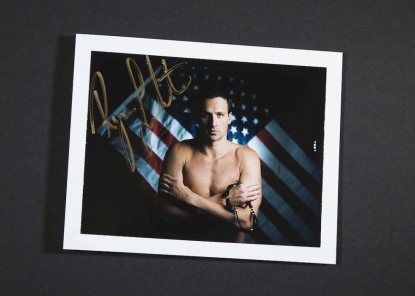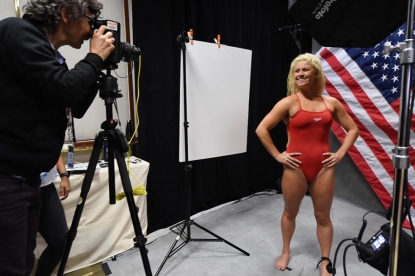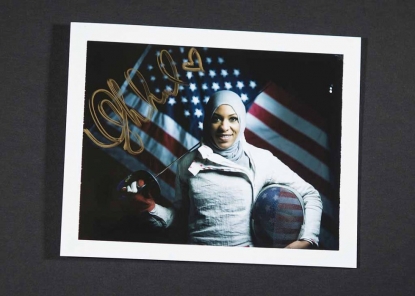Team USA in Polaroid
Los Angeles, March 23, 2016 -- Every four years, a few months before the Olympics, the same old ritual takes place here in California -- Team USA’s photo sessions for the media. The sessions usually produce the same old photos -- the smiling athlete in front of the Stars and Stripes.
Coming up with an original approach to this ritual can be a challenge. In 2012, my colleague Joe Klamar managed to come up with something new. Four years later, I was faced with the same dilemma -- how do I produce something different in an event during which everyone takes exactly the same photos? First I thought of using Instagram. And then I remembered the Polaroid.
 (AFP / Valerie Macon)
(AFP / Valerie Macon)You remember the Polaroid? For the younger generations, it may as well be a fossil. The only pre-digital camera that allowed to see a photo almost immediately after it was taken. The last ones were made nearly a decade ago, in 2007. Back in the olden days, Polaroids were often used in a photo studio to quickly check the light before shooting with a “proper” camera. For my Team USA experience, I intended to do the exact opposite -- check the light with a state-of-the-art digital camera before shooting with the old Polaroid.
For the special occasion, I rent a professional Polaroid, a 600-SE that must date to the 1970s or 1980s. My second challenge -- film. A few weeks back Fujifilm, the last company to make the famous “Film Pack 100” film for Polaroids announced that it was ceasing production. Since then the price for the film has skyrocketed -- on eBay, a pack of Polaroid film sells for 29 dollars, compared with 8 dollars that it was going for a few days earlier.
I rummage in my drawers and find a box of 10 of the precious film. I decide to buy five more boxes, which will leave me with 60 shots to both adjust the light and photograph the entire American Olympic Team.
 Ryan Lochte. (AFP / Valerie Macon)
Ryan Lochte. (AFP / Valerie Macon)The photo sessions take place in an enormous banquet hall at the Los Angeles Beverly Hilton Hotel. For the occasion, the hall has been subdivided into seven or eight temporary photo studio cubicles of three-by-three meters. The players trudge from studio to studio to pose and be photographed. It’s a bit of an assembly line.
'What's that?'
When they come to my studio and see my prehistoric camera, they’re a bit shocked. “What’s that?” they ask incredulously. I explain my idea -- first I’m going to take a snap of them with the Polaroid, then a few classic digital portraits, and then at the end have them sign the Polaroid with a gold marker (an idea from my editor Mladen Antonov). All of them love it. They’re thrilled to have a bit of fun in the middle of their infernal posing sessions. Since I’m not very tall, I take my photos on a stepladder, which amuses them even more. The atmosphere in my studio is instantly relaxed and gay.
 In action. (AFP / Robyn Beck)
In action. (AFP / Robyn Beck)At first I didn’t want to use the US flag as background -- everyone does it and I wanted something more original. But for AFP’s American clients, having the Stars and Stripes in the picture is important. And the athletes themselves don’t want to pose without their flag. It gives them confidence and defines who they are. Americans have very strong feelings toward their flag, something which is often difficult for Europeans to understand. So I end up using the flag.
When an athlete comes into my studio, I first take a shot with the Polaroid and then shoot some pictures with a digital camera. While I do so, a friend who is helping me develops the Polaroid, which takes a few minutes. At the end of the session, I show the picture to the athlete, who signs it with the gold marker before heading out.
 Donnell Whittenburg. (AFP / Valerie Macon)
Donnell Whittenburg. (AFP / Valerie Macon)Working with a Polaroid presents its own challenges. The lens doesn’t open that much, which results in darker photos than with digital cameras. The lens is not the fastest, making it difficult to focus. That ends up being most complicated for me -- focusing on the athletes who, used to modern cameras that capture multiple images in seconds, can’t stop moving. Meaning that I, with my ancient camera, have to start everything over again each time. Add to that the fact that my flash doesn’t always synchronise with the camera. Or that sometimes two photos come out at once. As I shoot, I keep looking nervously at my quickly dwindling stack of film.
Surprises
And then there are always surprises with Polaroid photos. On some, there are traces of emulsion. It’s not necessarily a bad result, but difficult to present to clients on AFP’s website. At first I scan the images as they are, but they turn out very flat, they need to have depth of field added. So I end up setting up a mini-studio at the office, to take photos of the photos that I took at my Hilton studio...
 Charlotte Drury. (AFP / Valerie Macon)
Charlotte Drury. (AFP / Valerie Macon)If I had to do it over again, I would have done a few things differently. For one, I had concentrated on the ‘stars’ of Team USA. It would have been nice to photograph less well-known athletes, like water polo players or horseback riders. But with only 60 shots, five of which were used to set the light, I had to make some choices…
Valerie Macon is an AFP photographer based in Los Angeles. Follow her on Instagram and visit her site. This blog was written with Roland de Courson and translated by Yana Dlugy in Paris.
 Candace Parker. (AFP / Valerie Macon)
Candace Parker. (AFP / Valerie Macon) Matt Grevers. (AFP / Valerie Macon)
Matt Grevers. (AFP / Valerie Macon) Allyson Felix. (AFP / Valerie Macon)
Allyson Felix. (AFP / Valerie Macon) Gabby Douglas. (AFP / Valerie Macon)
Gabby Douglas. (AFP / Valerie Macon) Jake Dalton. (AFP / Valerie Macon)
Jake Dalton. (AFP / Valerie Macon) Ibtihaj Muhammad. (AFP / Valerie Macon)
Ibtihaj Muhammad. (AFP / Valerie Macon) Maggie Steffens. (AFP / Valerie Macon)
Maggie Steffens. (AFP / Valerie Macon) The artist at work. (AFP / Robyn Beck)
The artist at work. (AFP / Robyn Beck)

